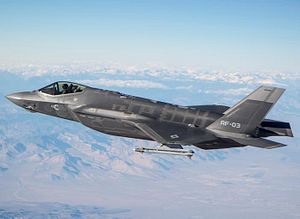On August 2, the United States Air Force (USAF) has officially declared its supersonic fifth-generation Joint Strike Fighter F-35A—the aircraft’s conventional takeoff and landing variant—combat ready, a press release by the Air Combat Command reveals.
“I am proud to announce this powerful new weapons system has achieved initial combat capability,” the commander of the USAF’s Air Combat Command, General Hawk Carlisle, said. “The F-35A will be the most dominant aircraft in our inventory, because it can go where our legacy aircraft cannot and provide the capabilities our commanders need on the modern battlefield.”
The 34th Fighter Squadron of the 388th Fighter Wing, based at Hill Air Force Base, Utah is the USAF’s first unit to achieve initial combat capability. A squadron usually consists of 12-24 aircraft. The head of Air Combat Command, in close consultation with the secretary of the Air Force, has the final say in clearing a new combat aircraft for deployment.
Initial combat capability (aka initial operational capability) is declared after the squadron’s aircraft have met a number of criteria. Amongst those are the capabilities to conduct basic close air support, air-to-air combat, as well as the limited suppression and destruction of enemy air defenses in a hostile environment.
In addition, logistical and operational systems have to be in place to support a combat deployment. According to the “Defense Acquisition Acronyms and Terms Glossary,” initial operational capability is “attained when some units and/or organizations in the force structure scheduled to receive a system have received it and have the ability to employ and maintain it.”
In August 2015, the United States Marine Corps’ (USMC) first ten F-35B — one of three designs of the multi-role fighter — of Marine Fighter Attack Squadron 121 (VMFA-121), based in Yuma, Arizona, were cleared for worldwide deployment after a five-day operational readiness inspection (See: “Finally! US Marine Corps Declares F-35B Operational”).
A F-35A fighter jet also recently achieved its first live air-to-air kill, according to the aircraft’s maker, U.S. defense contractor Lockheed-Martin. On July 28, at a military test range off California, an F-35A launched an AIM-9X air-to-air missile and destroyed an aerial drone target. The F-35A can carry two AIM-9X, short range, heat-seeking missiles under its wings. During the test flight on July 28, the F-35A also fired an AIM-120C missile, carried in the aircraft’s internal weapons bay, against another unnamed aerial vehicle beyond visual range. The missile was given a self-destruct signal shortly before reaching its target.
Both the F-35A and F-35B variants are now in their minimal deployable forms and will continue to undergo various tests and upgrades. Particular attention will be paid to fine-tuning the aircraft’s complex computing systems. In a interview in June, the F-35 systems management office chief and lead for F-35 operational requirements at Air Combat Command, Colonel David Chace, said that the aircraft can be deployed to both Iraq and Syria after achieving initial operational capability (IOC): “After IOC, it will be available to support the needs of the combatant commanders.”
Full-rate production of the new aircraft is scheduled to begin in 2019. The USAF is expected to receive a total of 28 F-35A fighter jets this year. The U.S. Department of Defense is planning “to procure 2,457 aircraft by 2038. Total acquisition costs are estimated at over $400 billion making it the U.S. military’s most expensive acquisition program. Operation and support costs throughout the aircraft’s lifetime are estimated at over a $1 trillion,” I reported in November 2015 (See: “F-35 too Expensive: US Air Force Might Buy 72 New F-15 or F-16 Fighter Jets”).
































